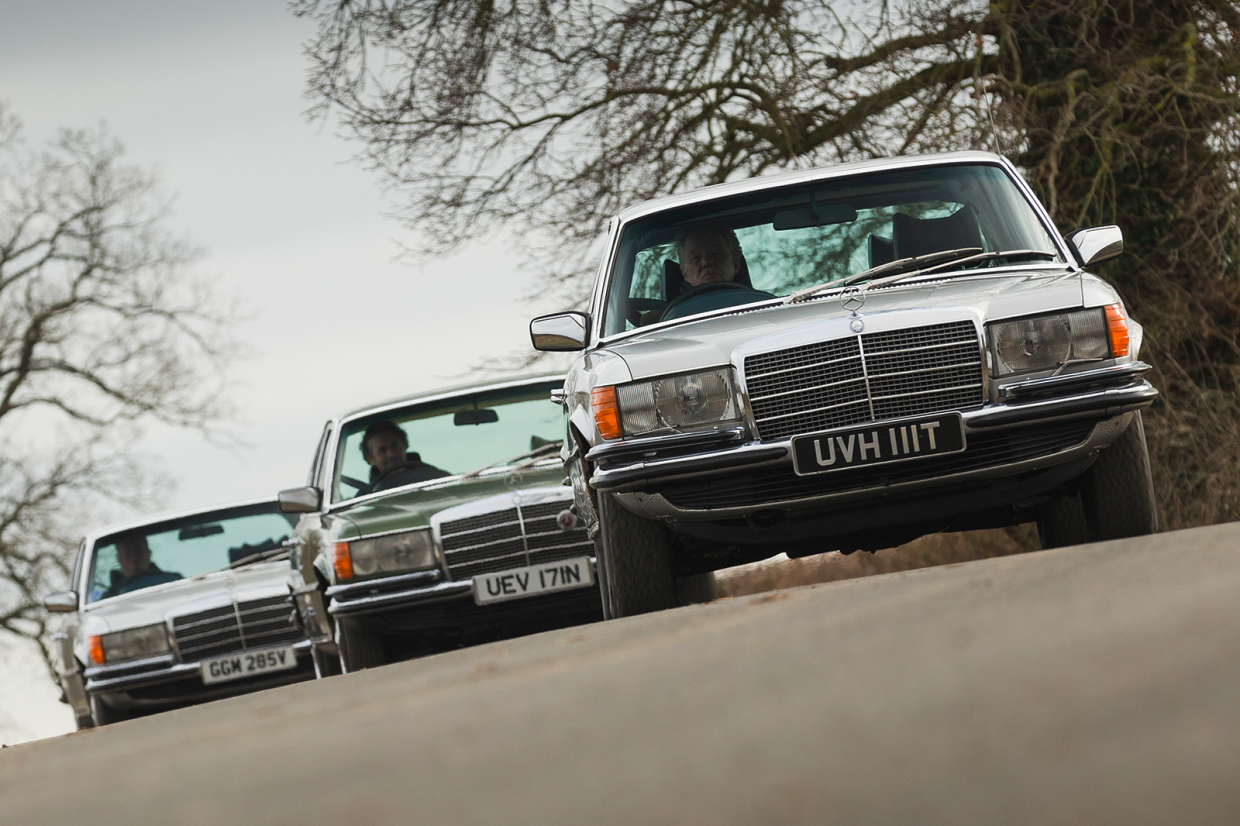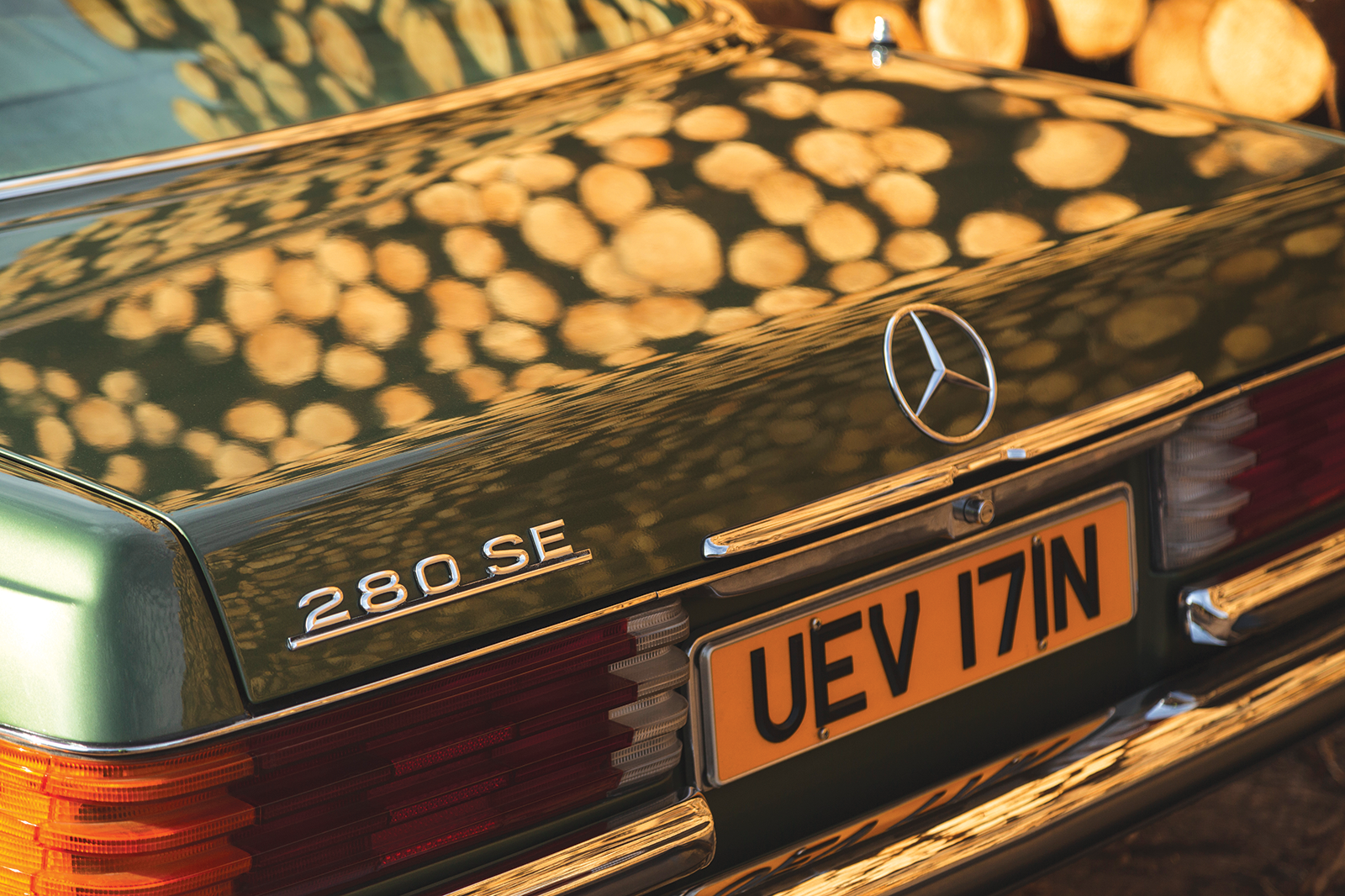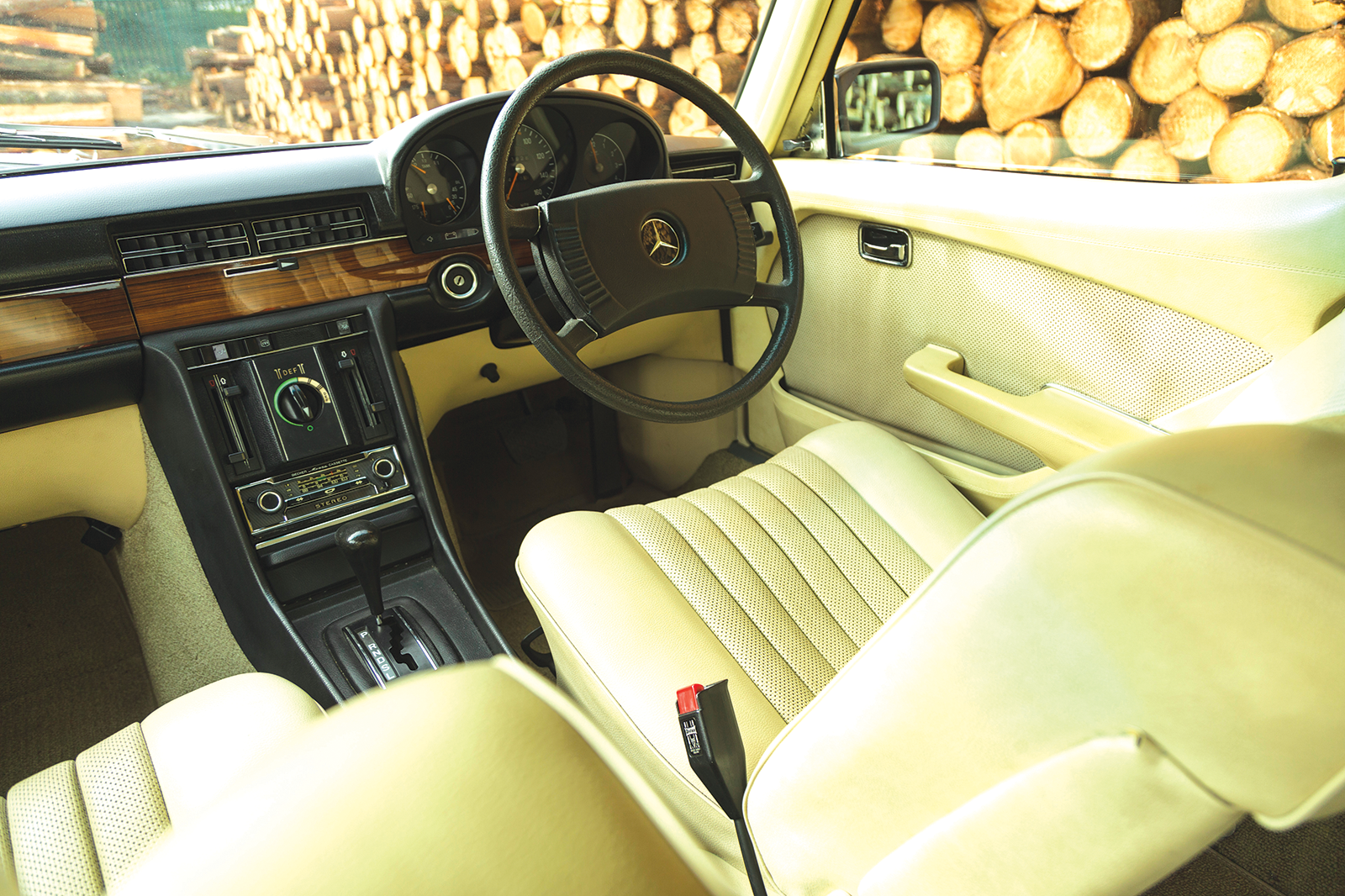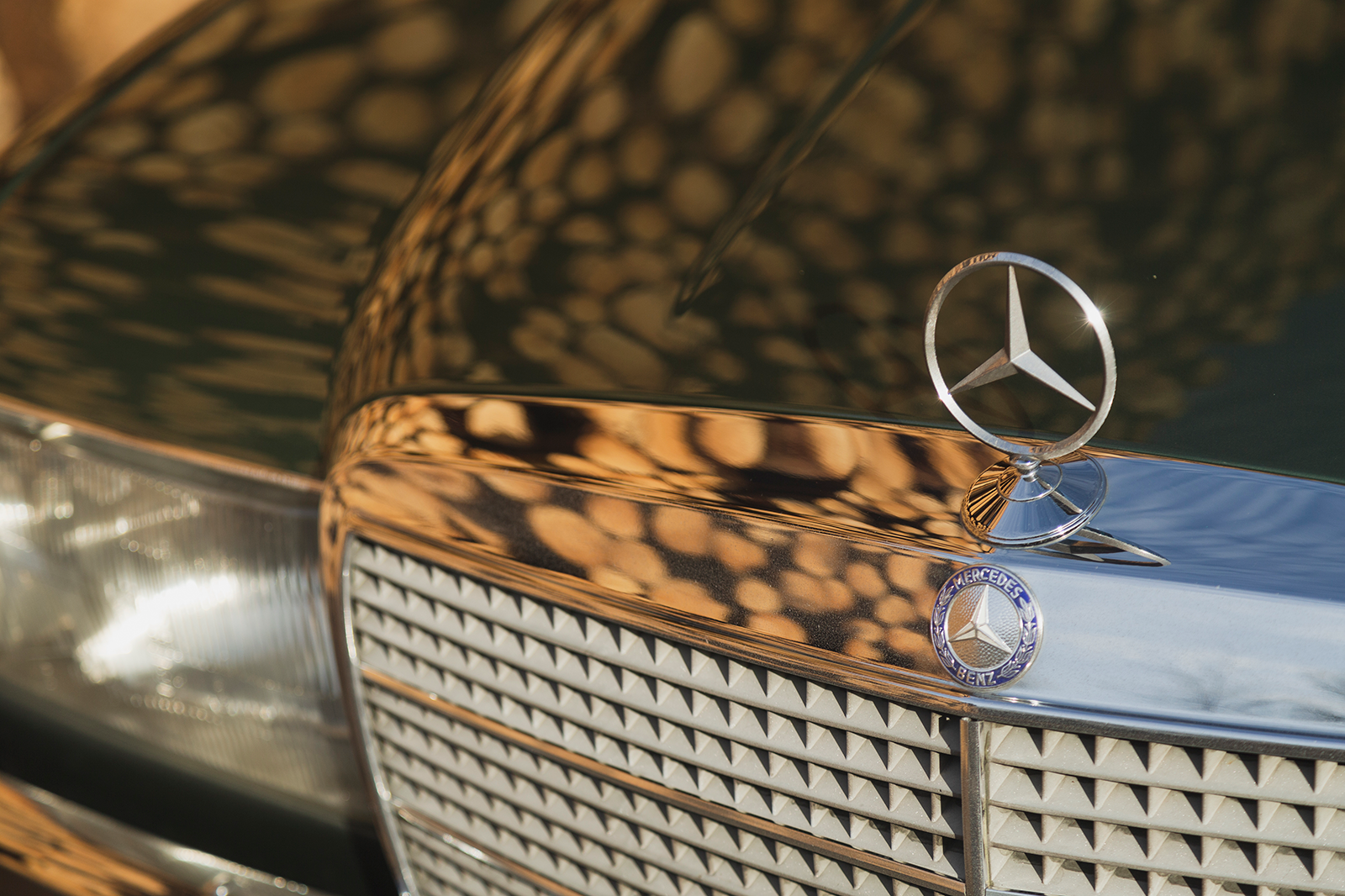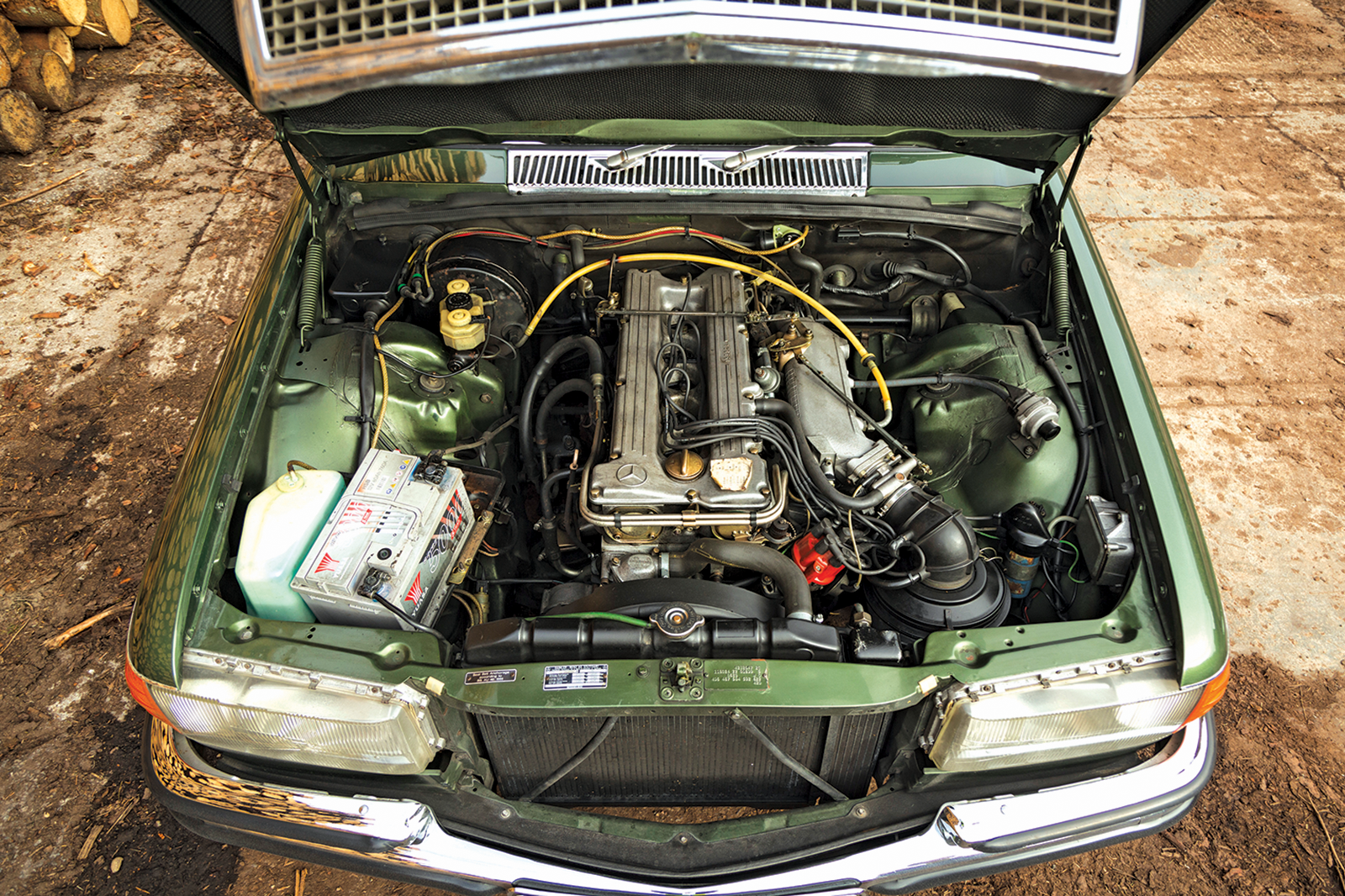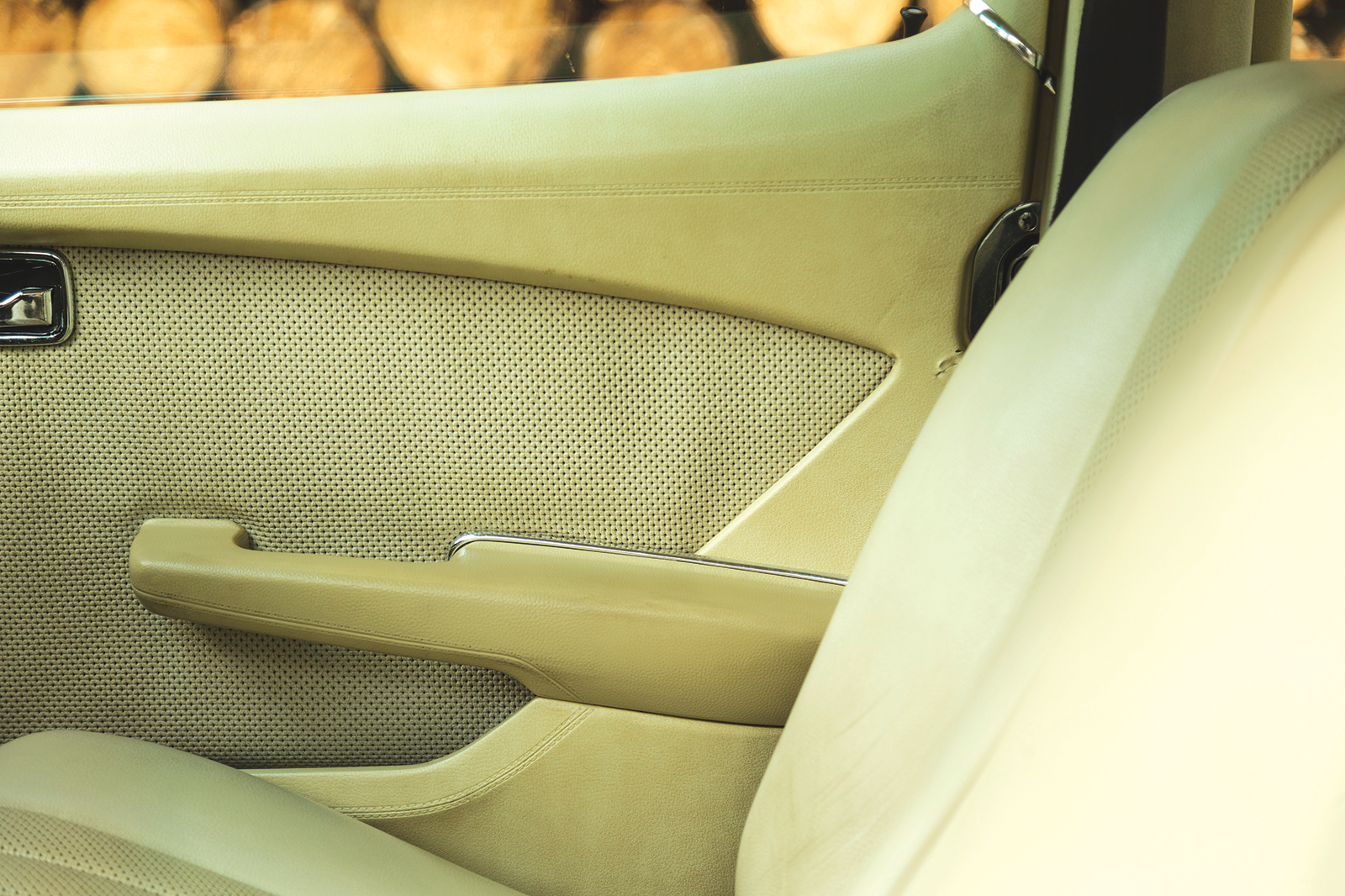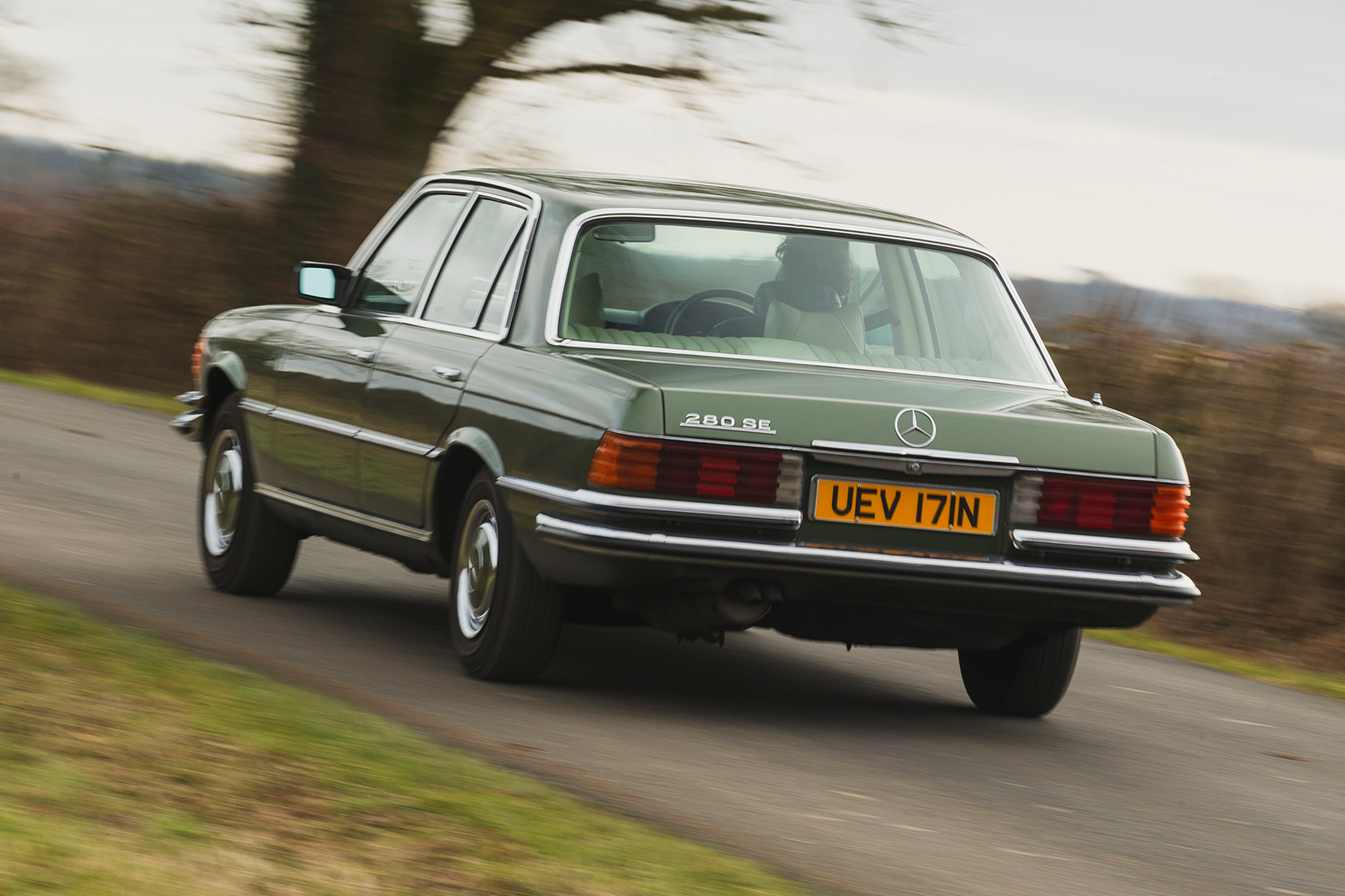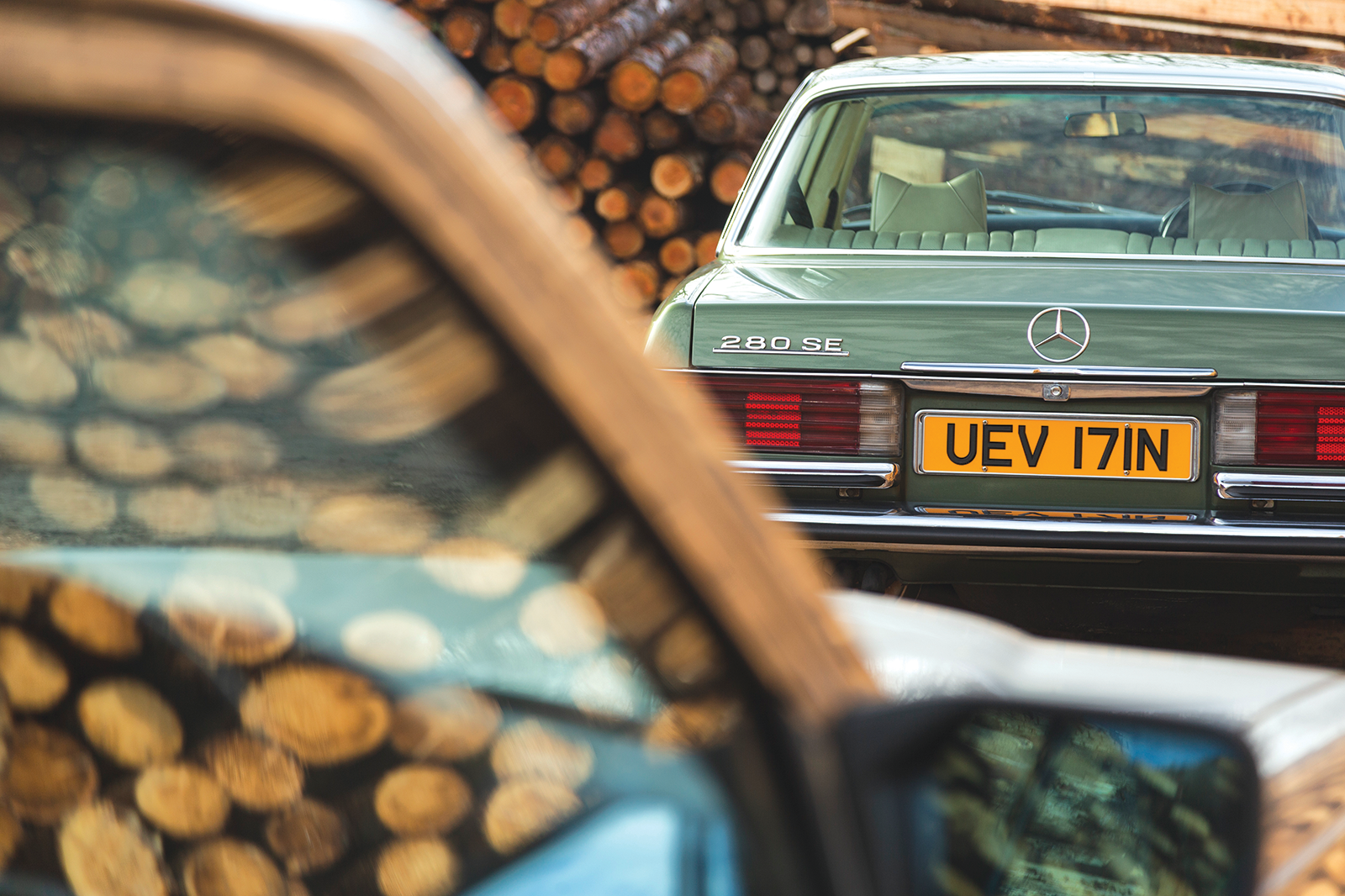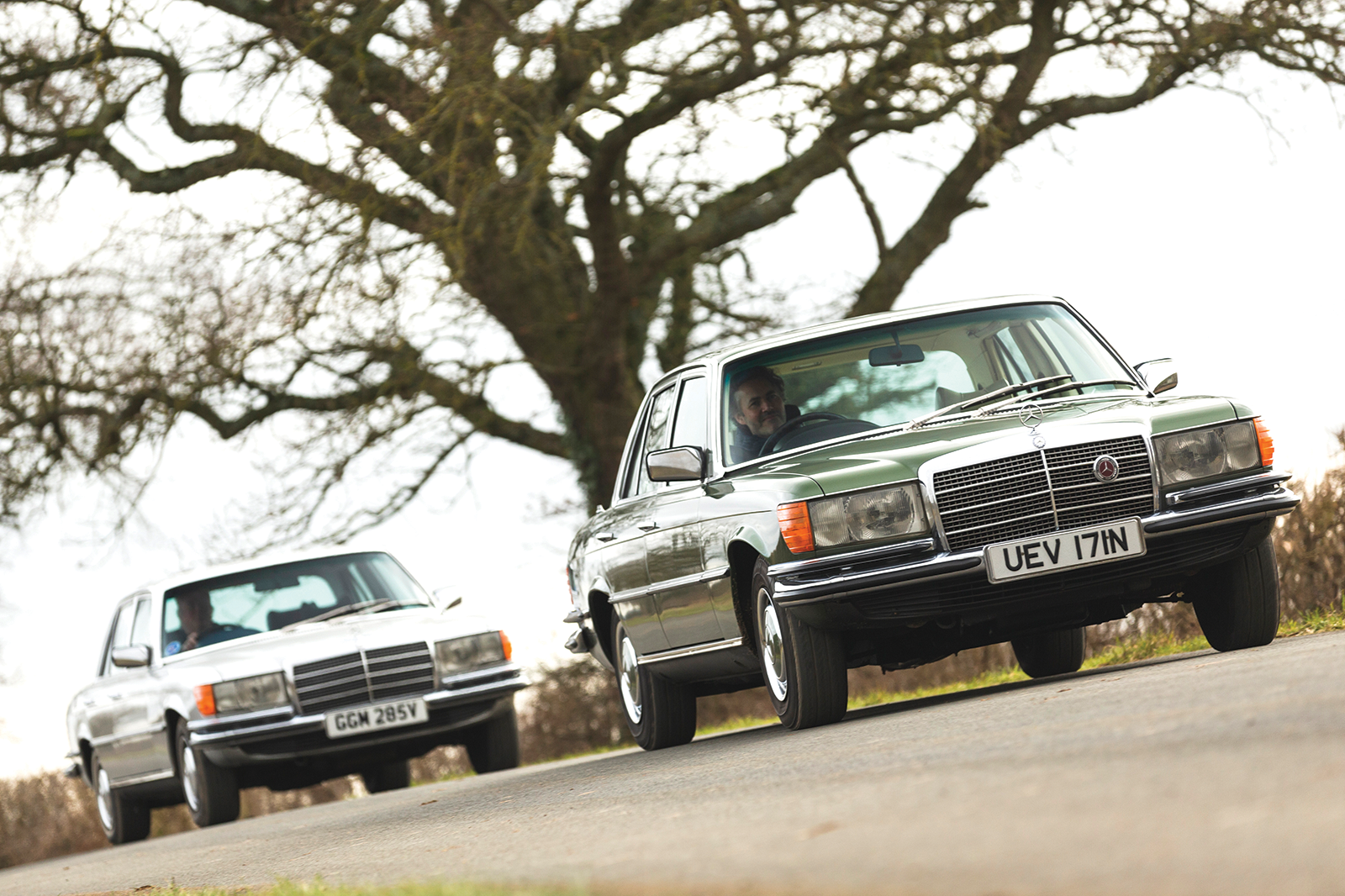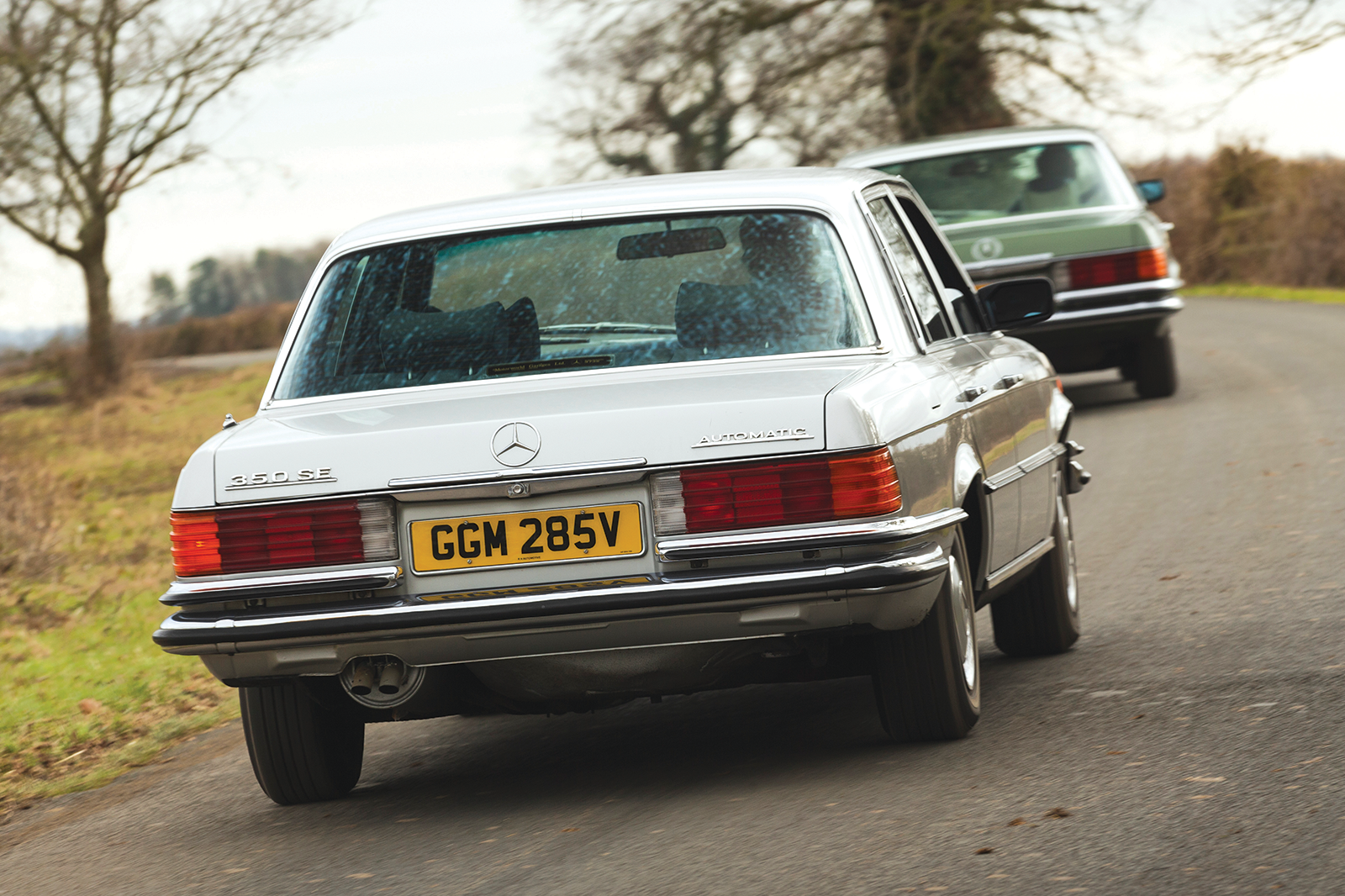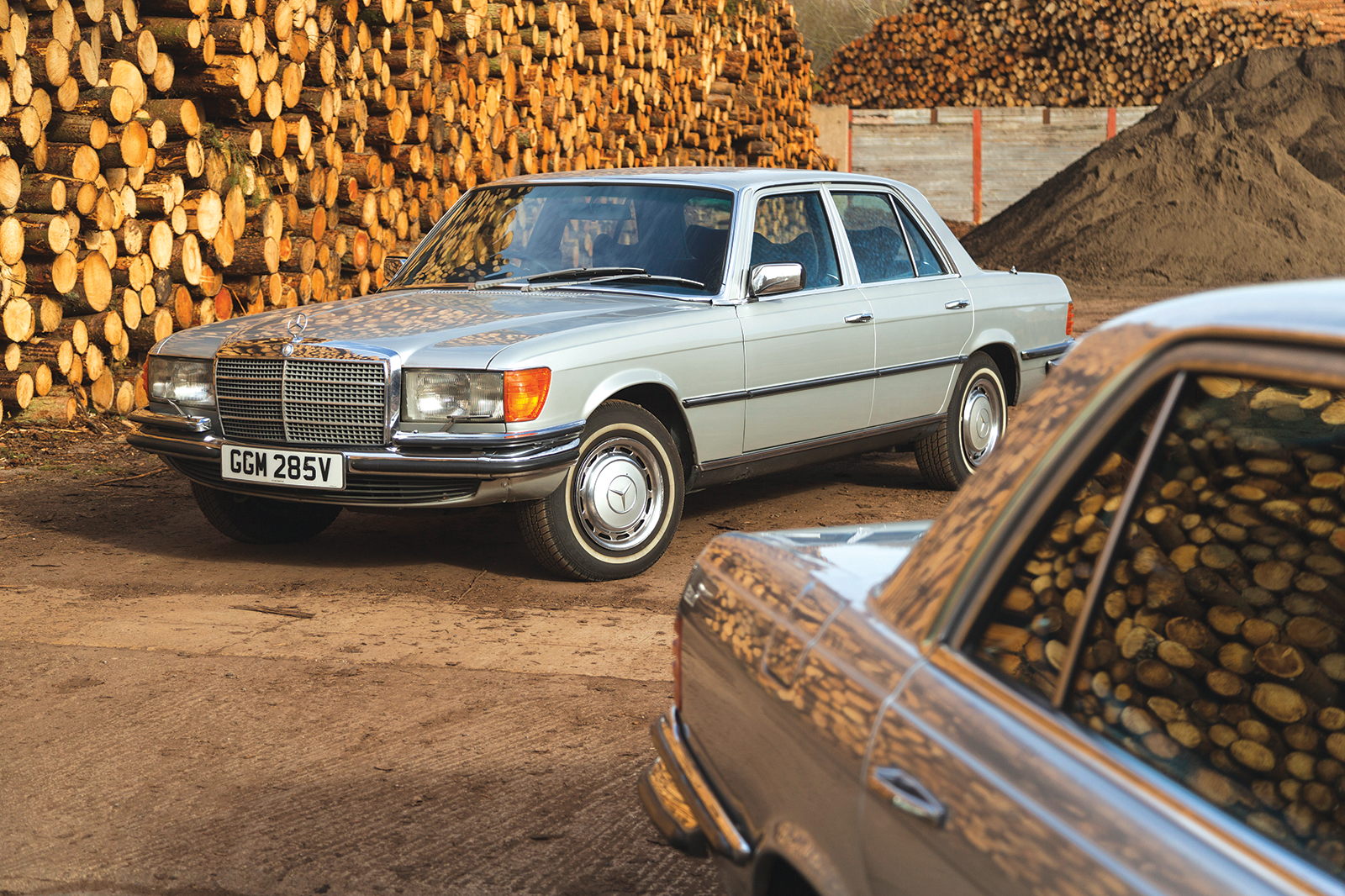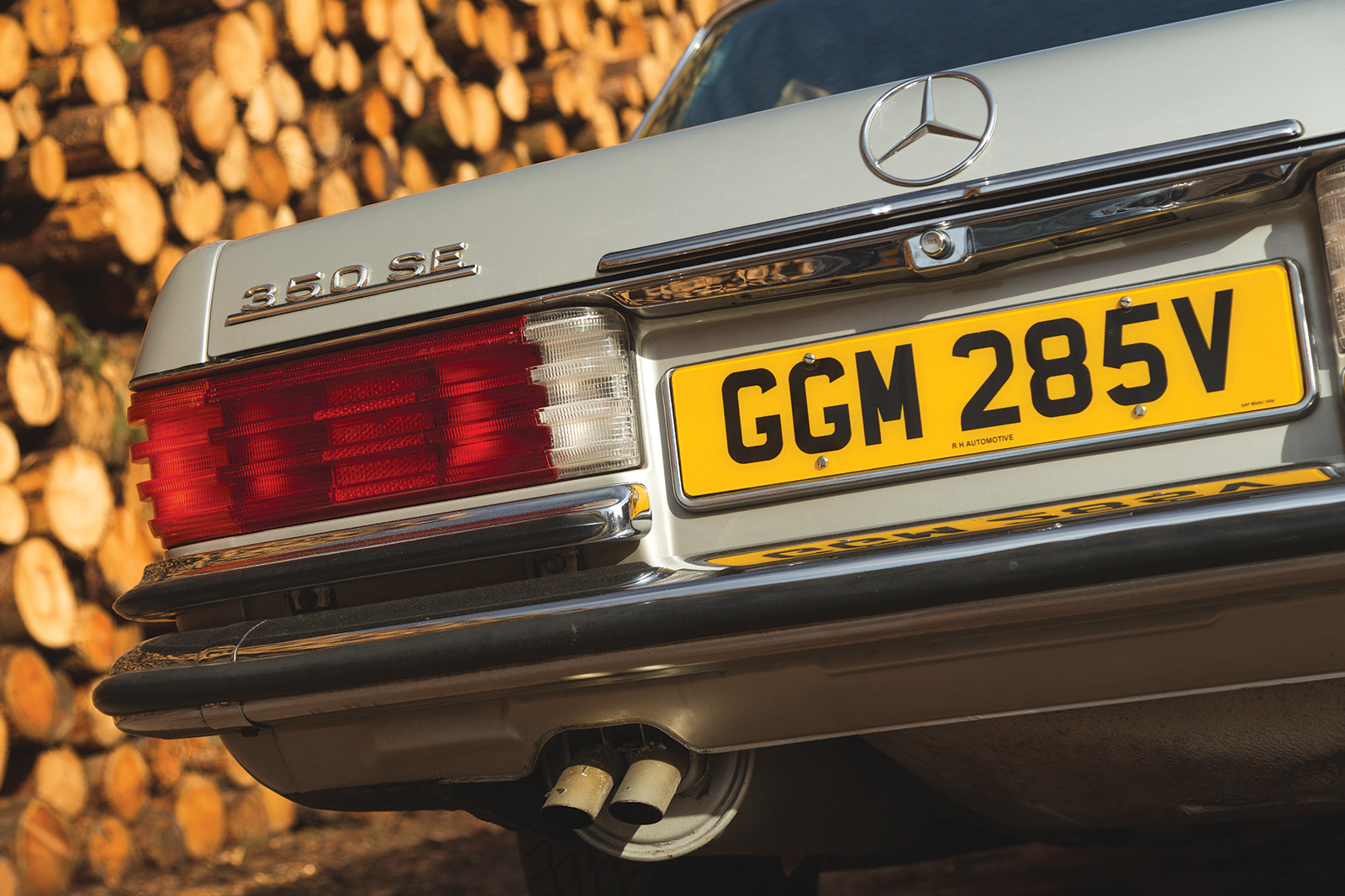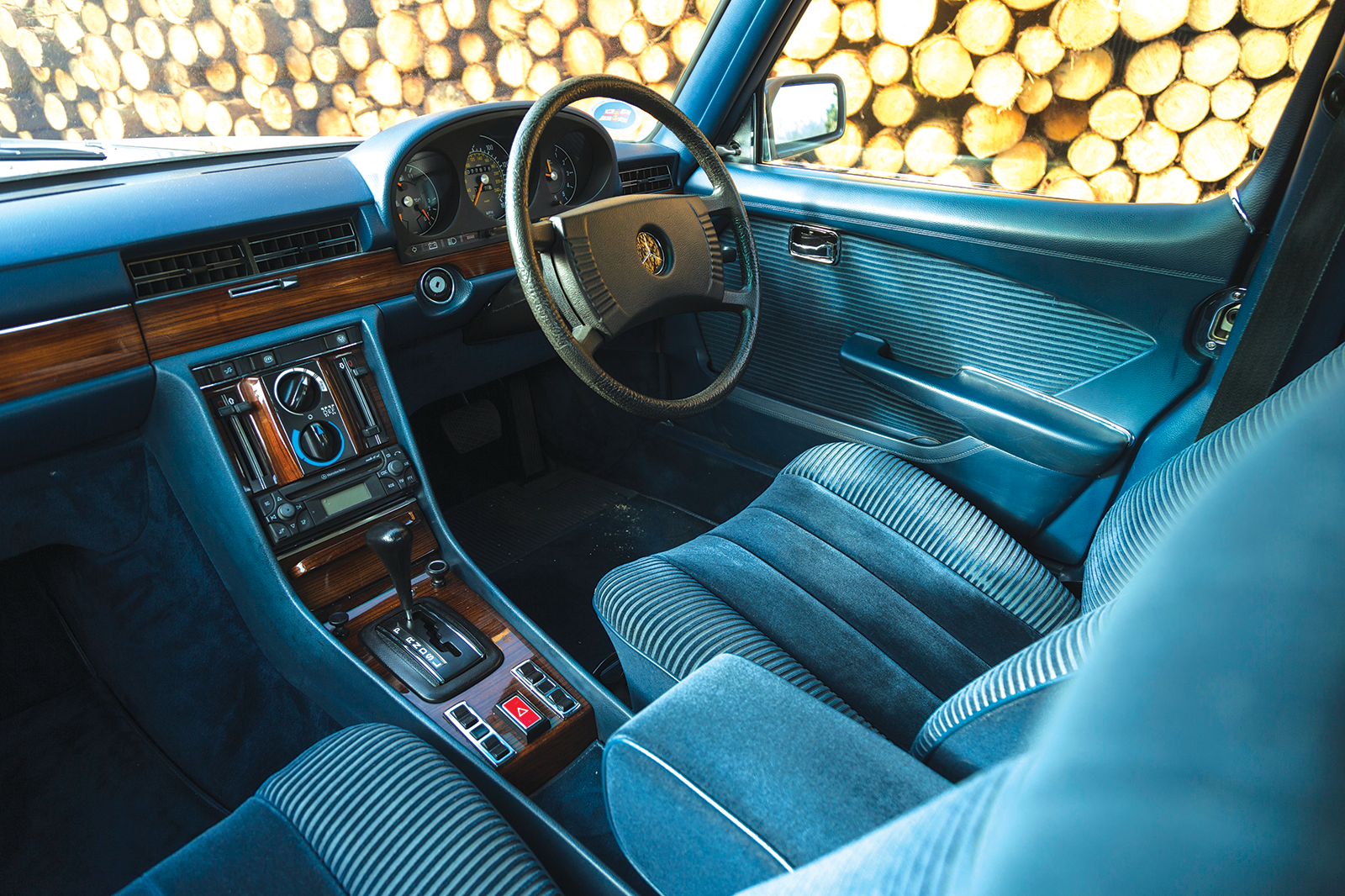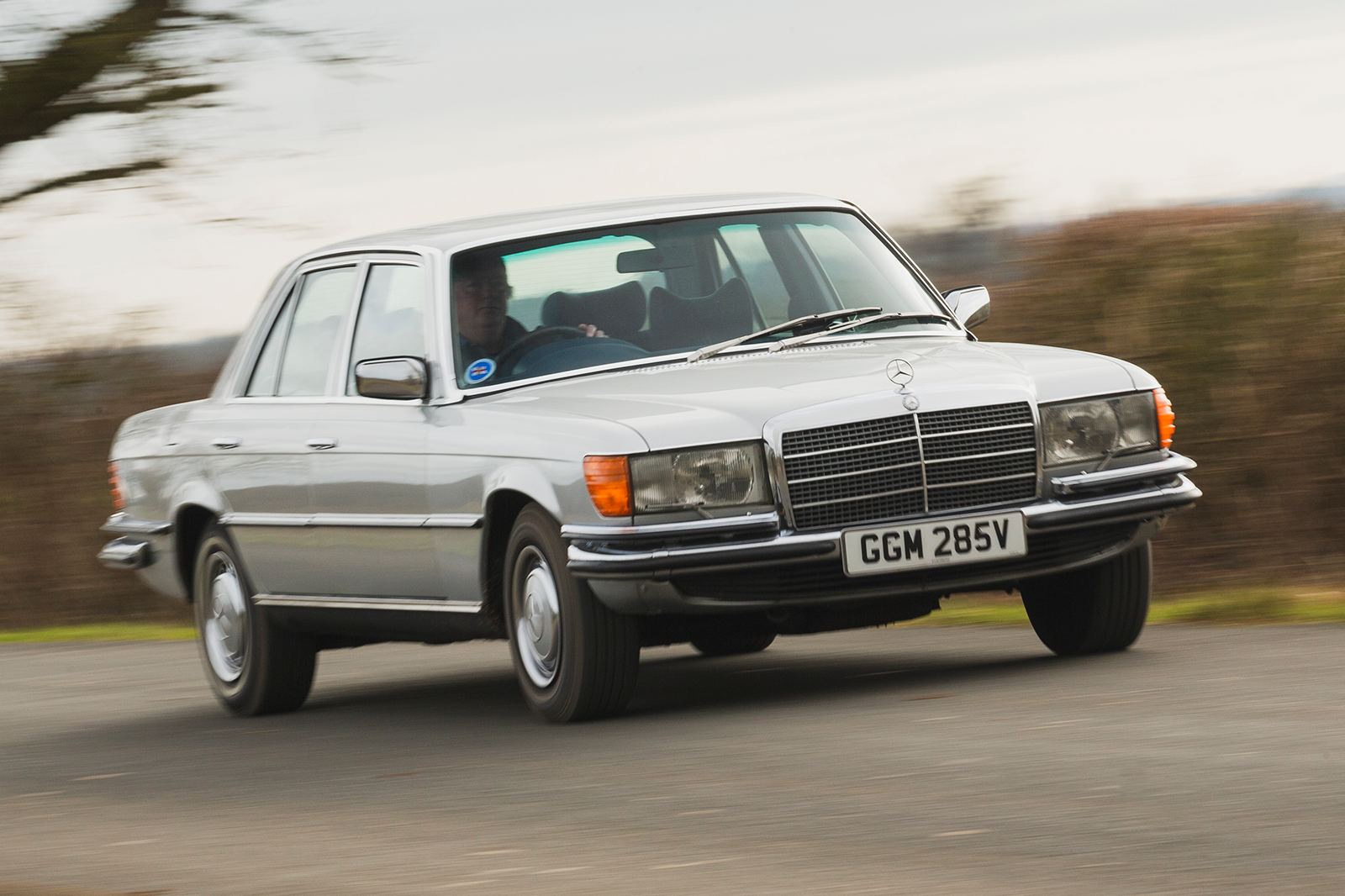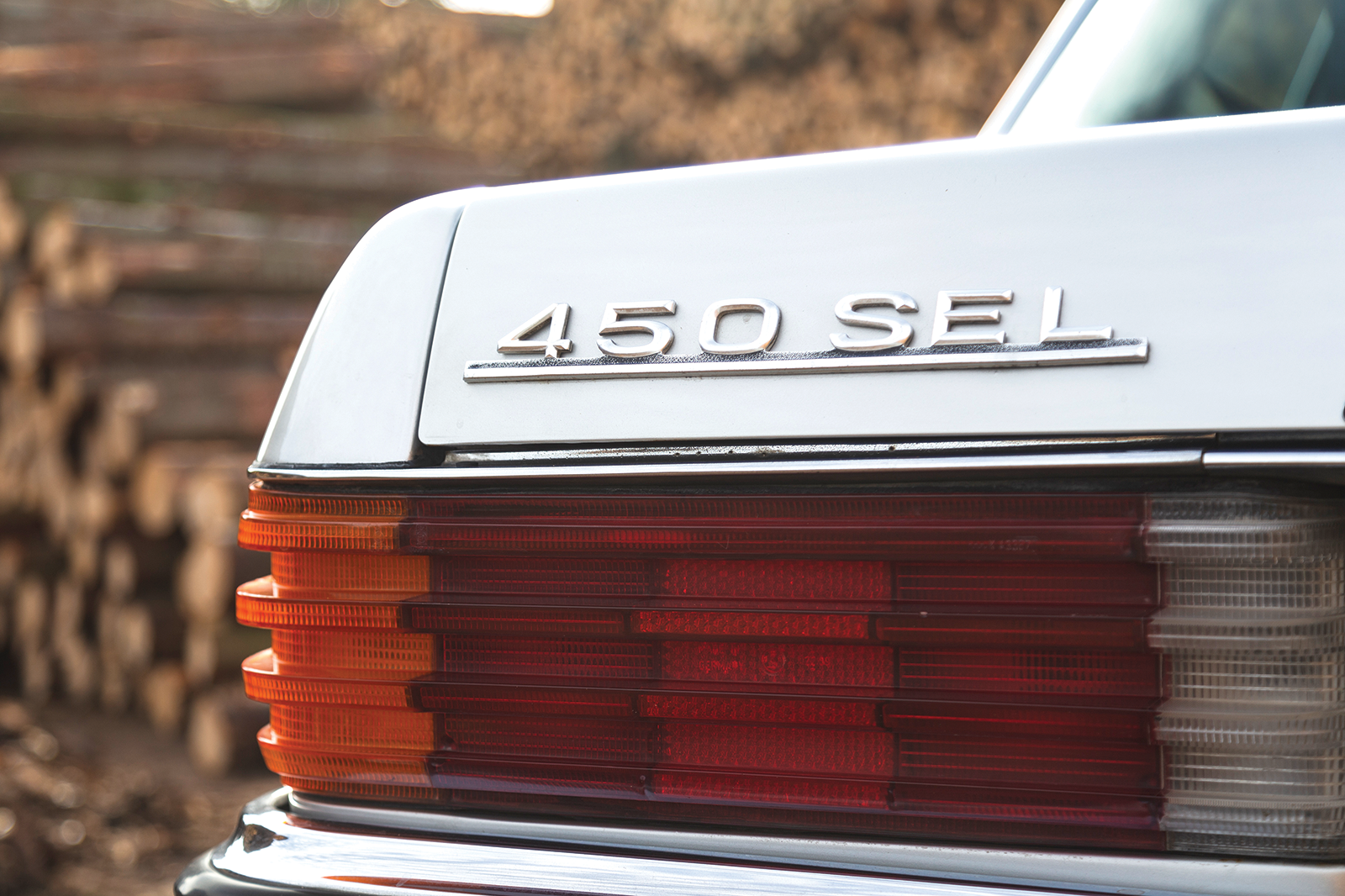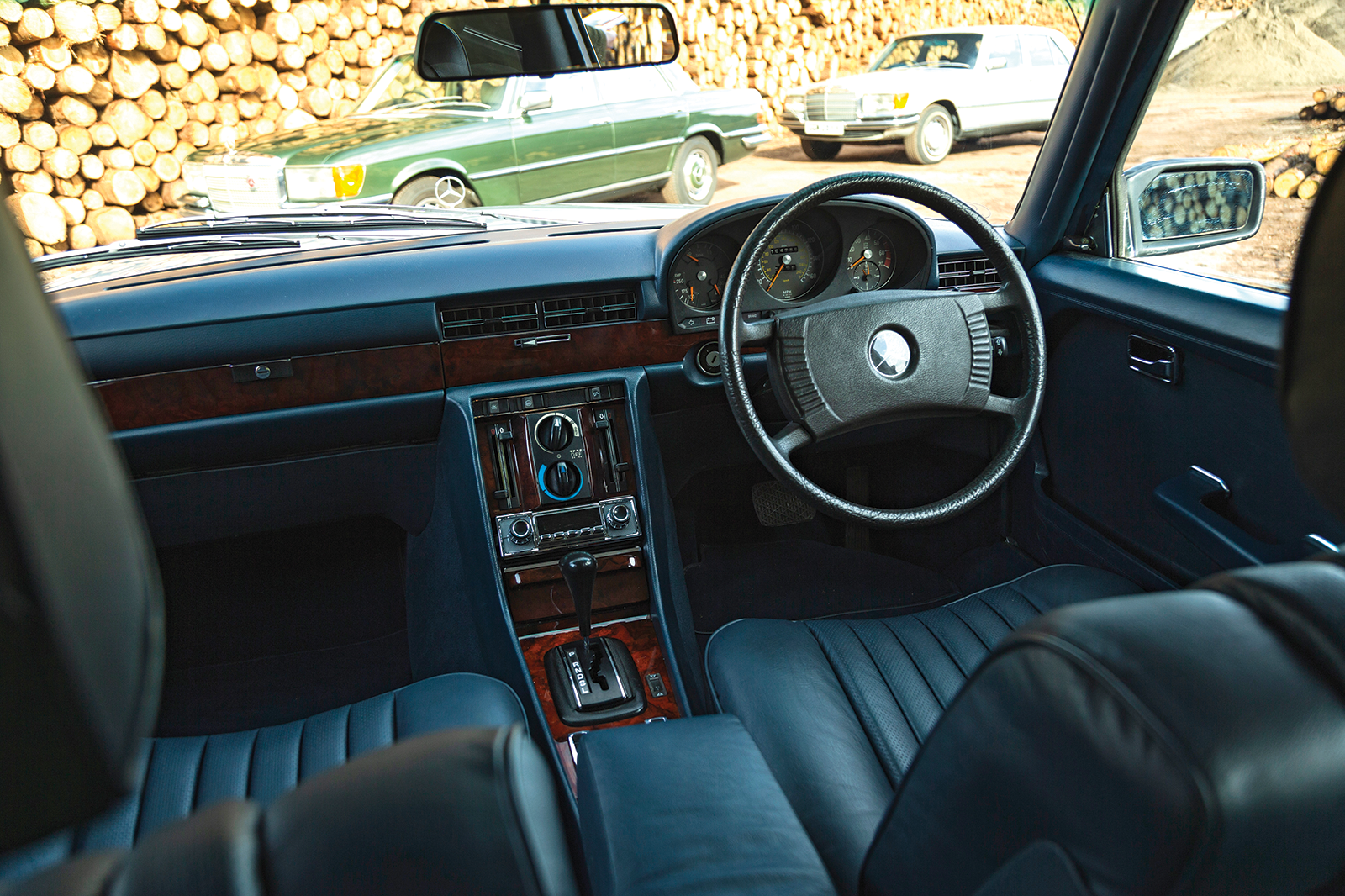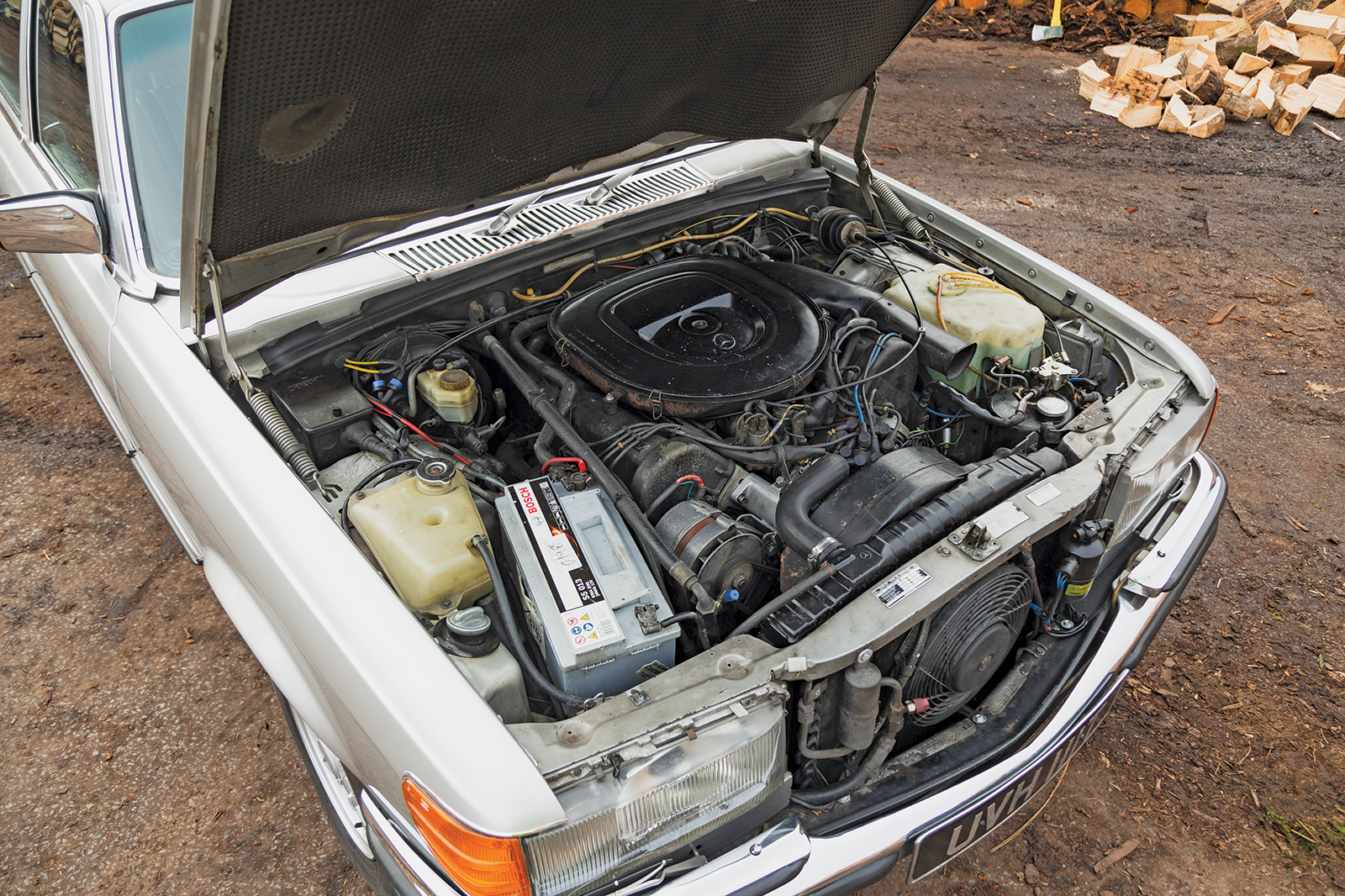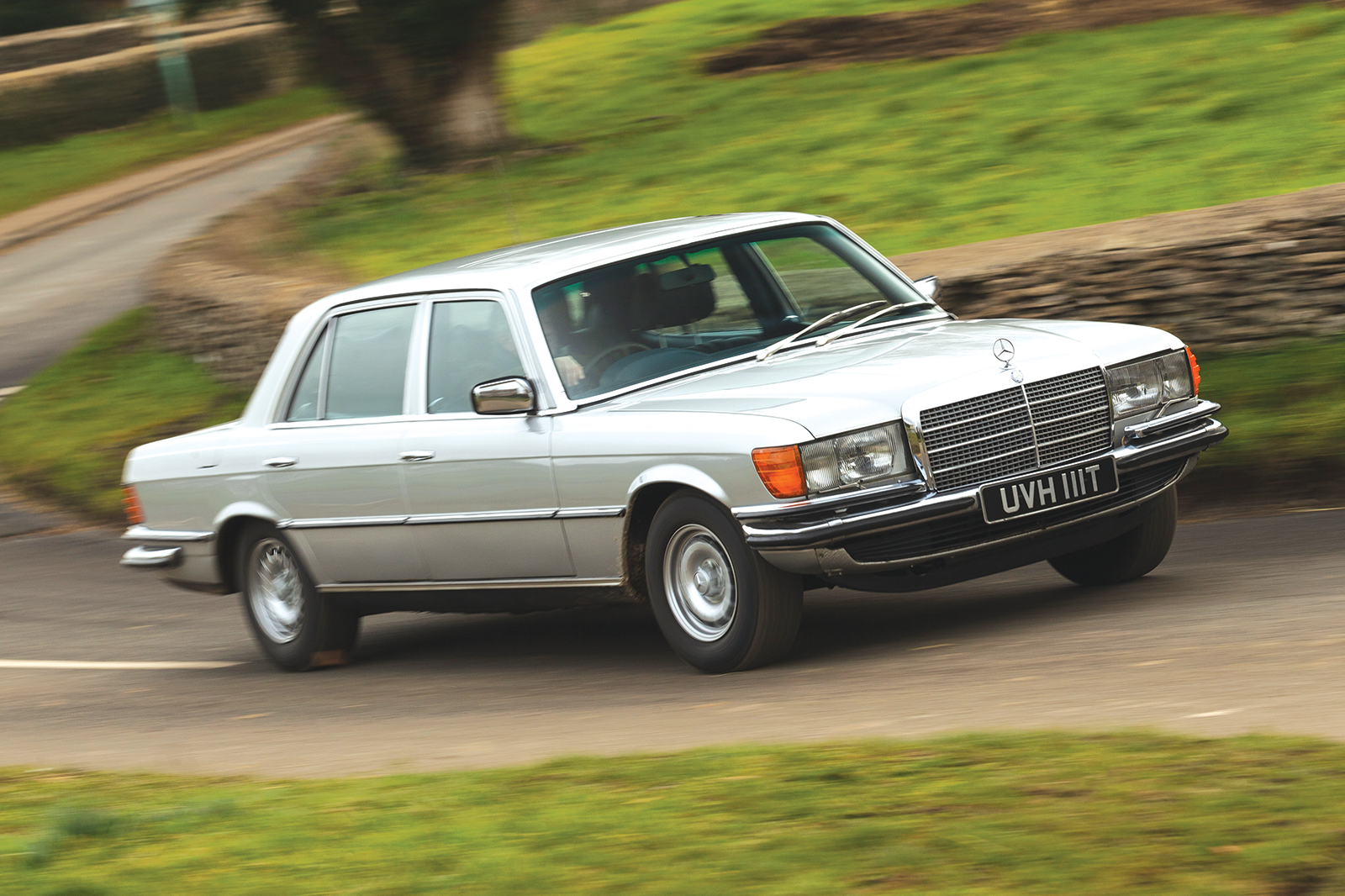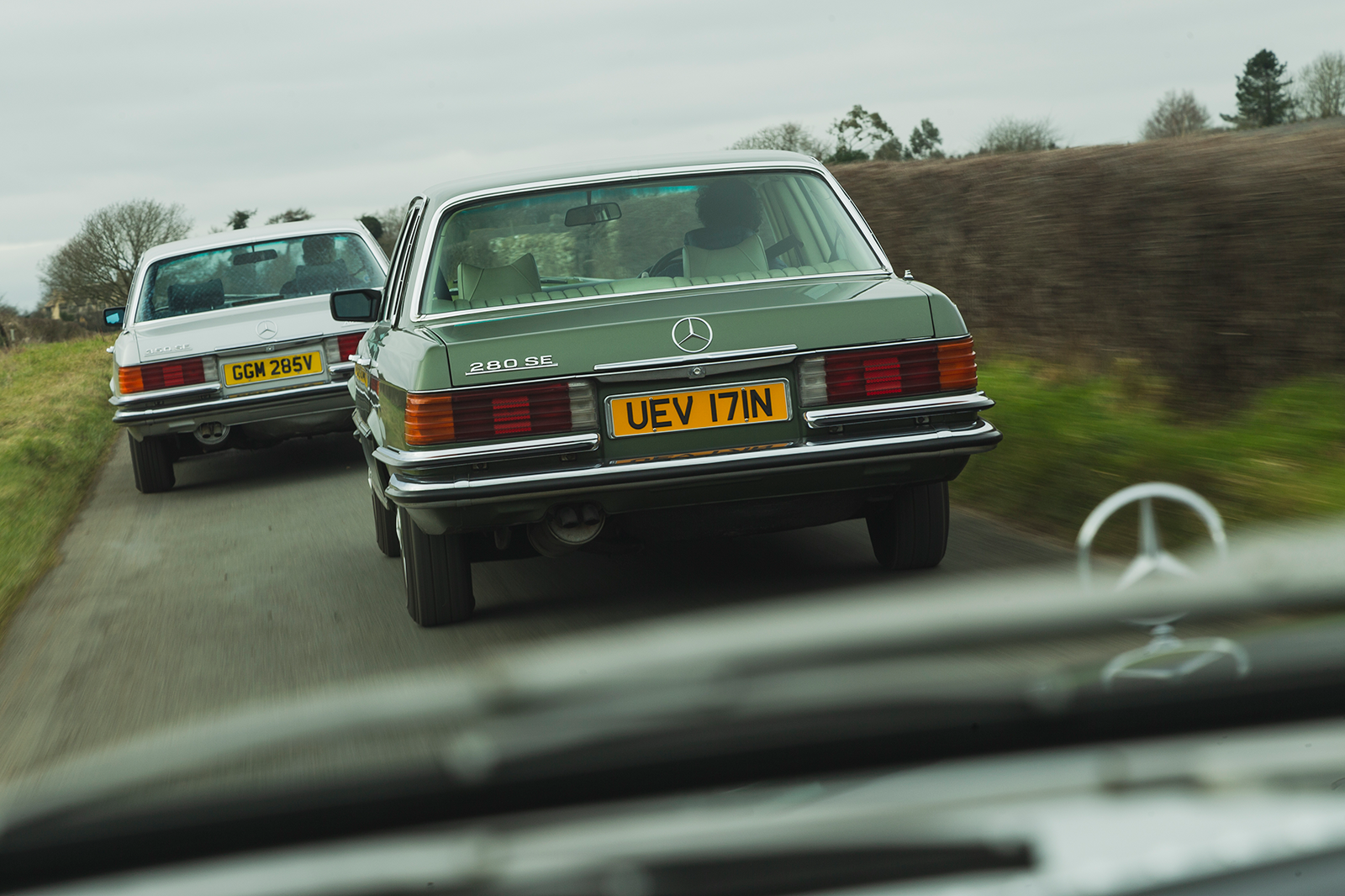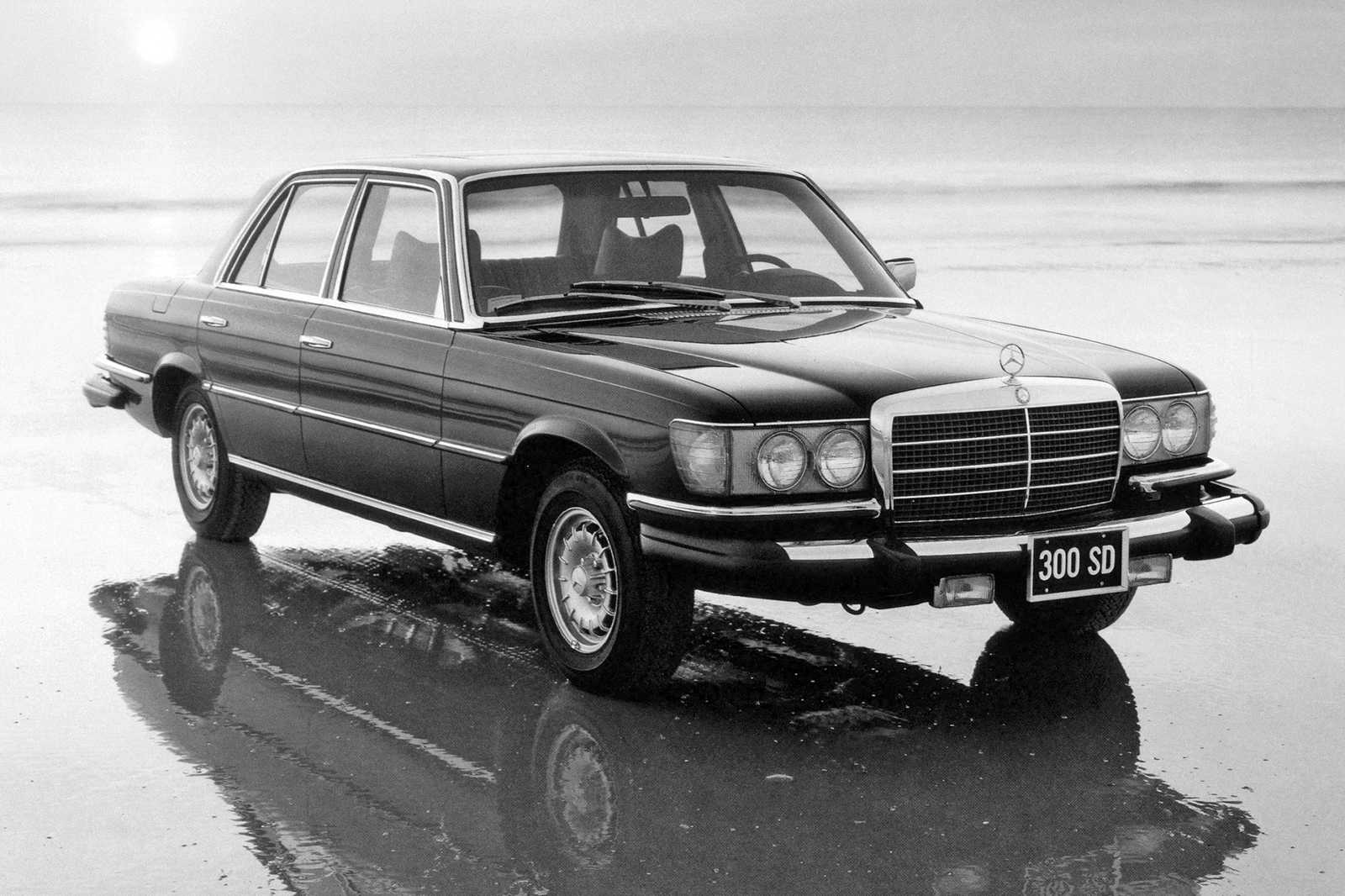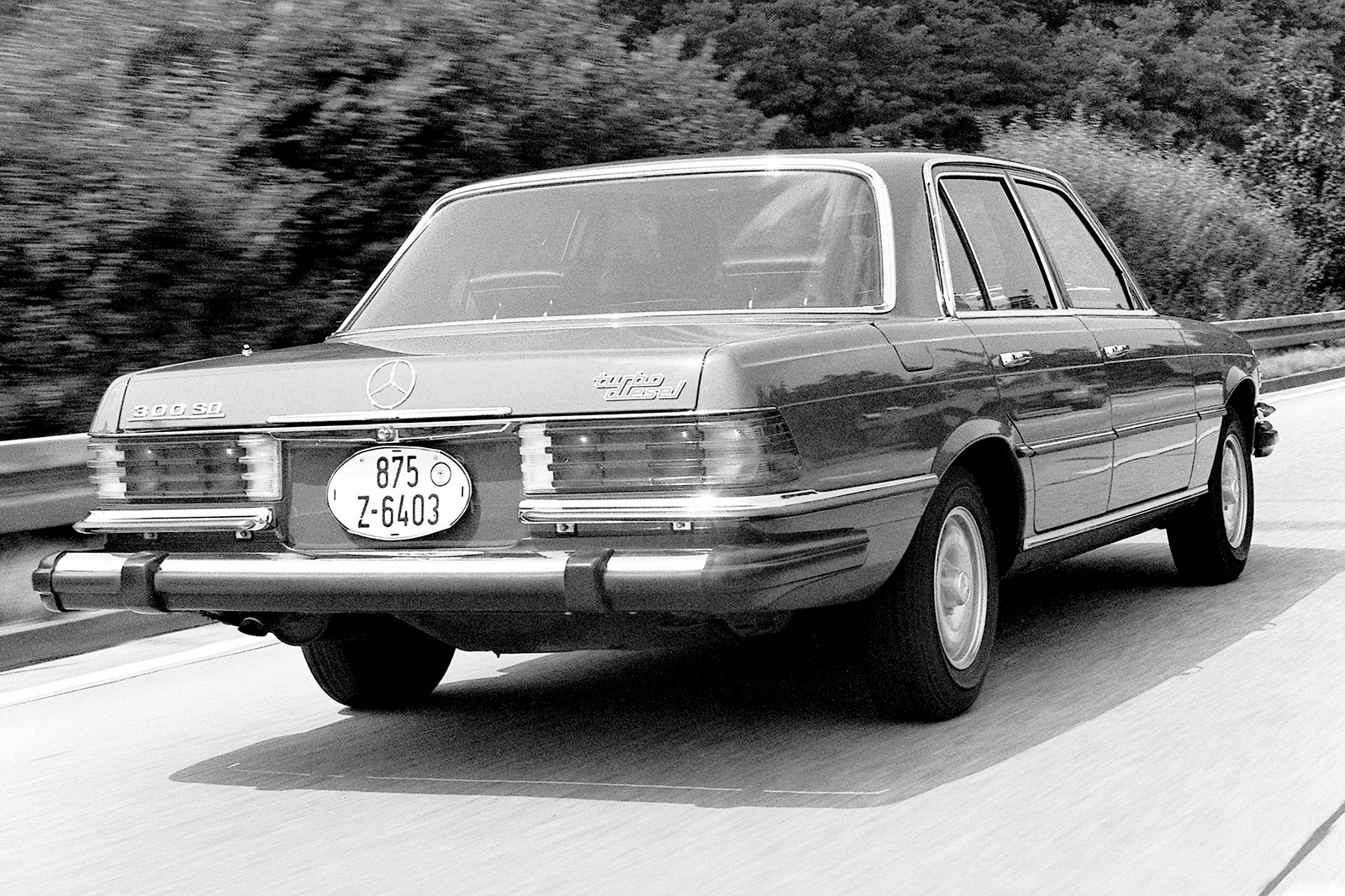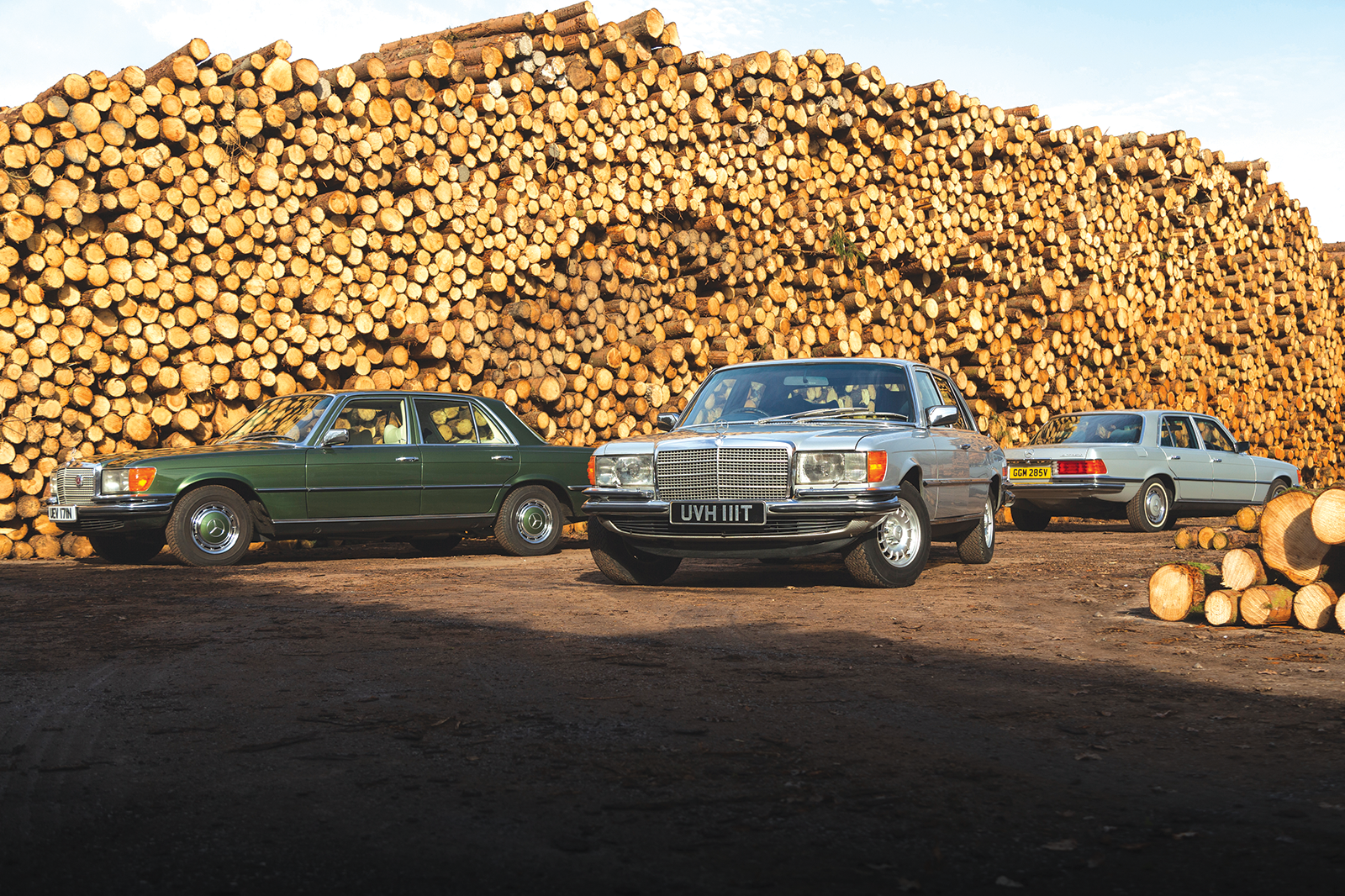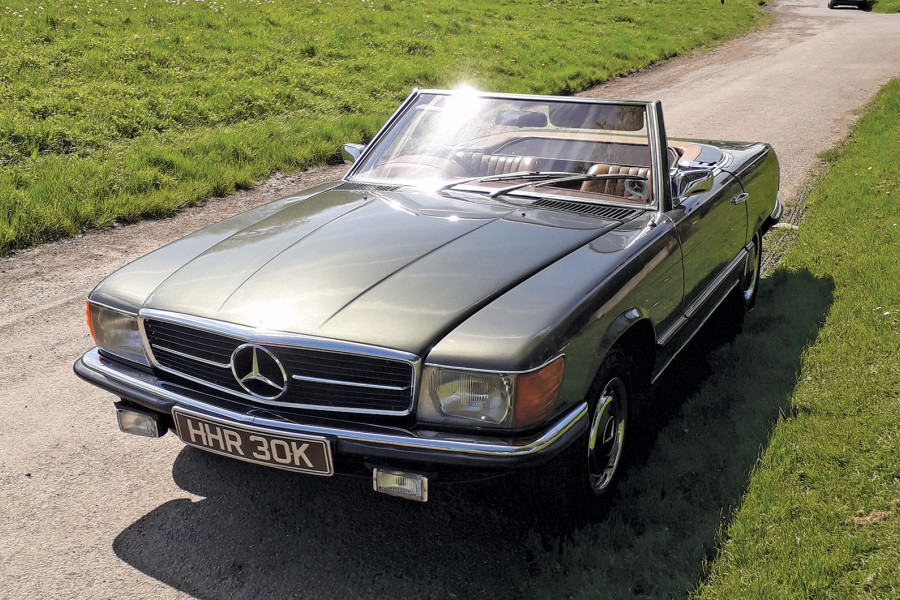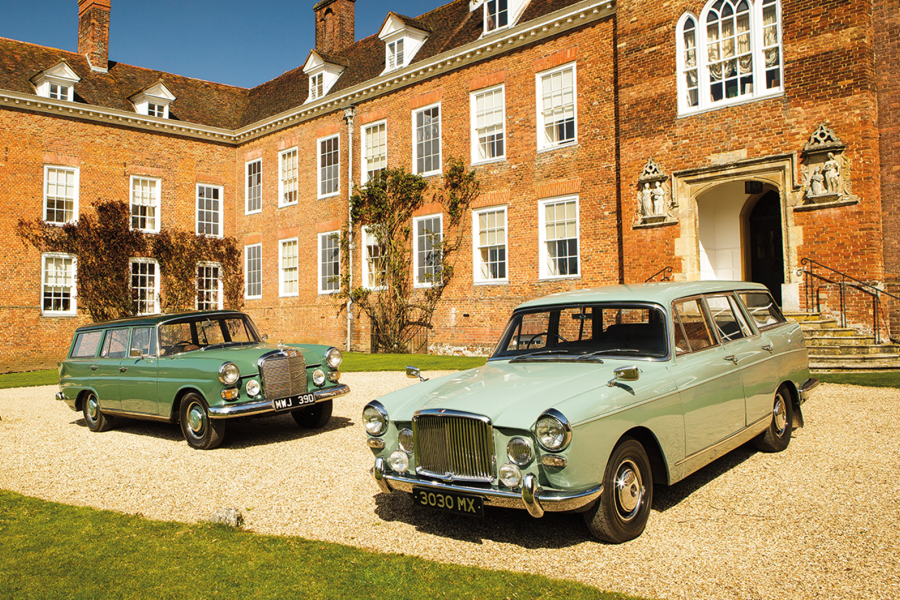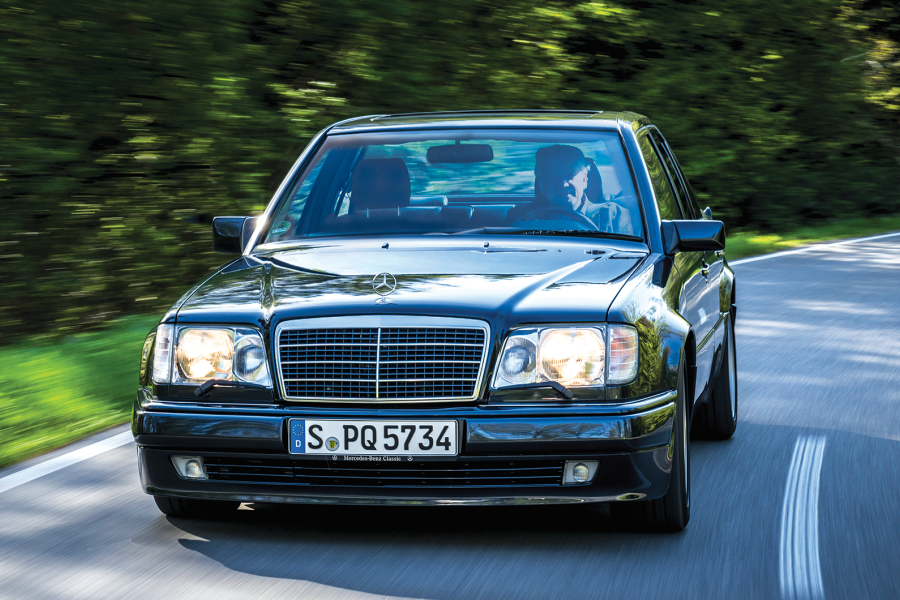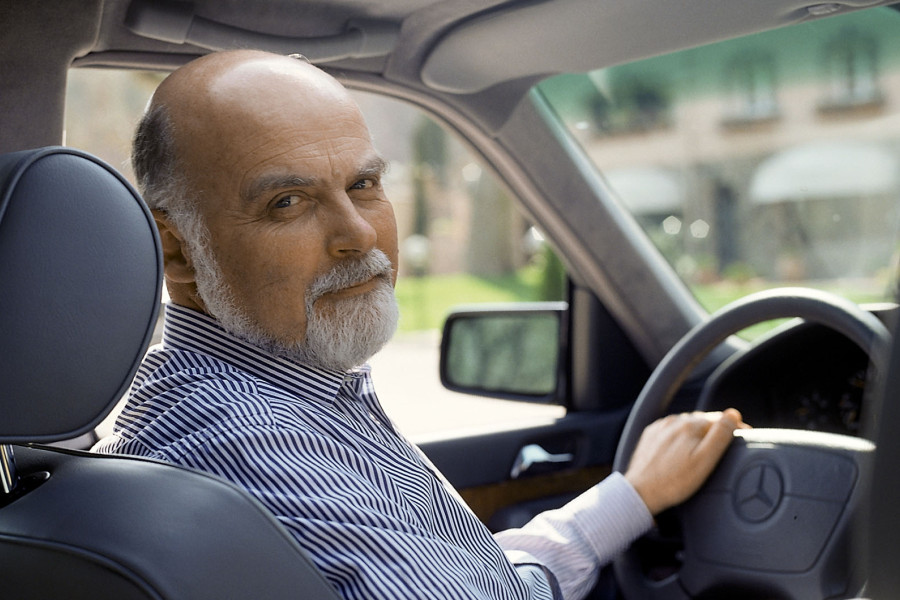The velour in the 350SE holds you best during cornering – all versions roll, but not to excess – and has a very particular and pleasing smell.
Equally, I like the cheerful practicality of the 280SE’s MB-Tex, while actively preferring the straight-grained wood on its dashboard.
The handsome twin-cam ‘six’ in the 280SE (the M110) looks approachable; the M116 V8 in the 350SE less so, although everything is easy to find in terms of getting to – and topping up – the fluids.
The compact 3499cc V8 in Mercedes’ 350SE was the most potent engine available from launch
Yet there is something almost industrial about the mechanically injected, dry-sump M100 V8.
With its bulging cam boxes, giant battery and mysterious-looking suspension pump it fills the available space.
On the road, the smaller of the two V8s is sweeter, smoother and quieter than the thunderous 6.9, and naturally pulls shorter gearing so there is always acceleration on tap even at autobahn cruising speeds, which can’t do much for fuel consumption.
Interestingly, Motor got 13mpg from its 350SE, and Autocar extracted the same from its road-test 6.9.
This classic Mercedes-Benz 350SE shows off the clean profile of the 116-series
At just 23.9mph per 1000rpm, the lower-revving 6.9 works on much the same principle.
But with virtually double the peak torque – produced at much lower revs – there is an urgency to the acceleration that still generates a thrill, no matter how many times you drive one of these cars.
The way the 6.9 slingshots down a motorway slip road and insinuates itself into – and then pulls away from – fast-moving traffic remains something to behold in a car this large, heavy and old.
‘In their disco era, neither Cadillac nor Lincoln had a credible answer to the unforgiving excellence of Stuttgart’s finest’
Hold it in the 103mph intermediate gear or just let the transmission work things out itself; either way the nose lifts, the engine rumbles and you are where you wanted to be almost before you have had a chance to decide if it was really a good idea or not.
The cornering limits of the 280 and 350 are way beyond what you could safely discover on the road and both of these cars feel capable even now, the secret of their stability lying with that zero-offset geometry and large amounts of castor, plus three turns of the wheel between tight locks and plenty of steering feel.
Likewise the 6.9, except to say that large throttle movements should be treated with caution in anything but a straight line, and will certainly result in untidy fishtail slewing of a very ‘instant’ character if the road is damp.
The 286bhp 450SEL 6.9 was sold in small numbers compared to the rest of Mercedes’ 116-series range
The steel-sprung cars are set up to ride best at high speed, but they feel slightly ordinary and lumpy the rest of the time.
In contrast, the hydropneumatics of the 6.9 make the ride feel much more sophisticated and expensive – if slightly floaty on the sort of minor roads that tend, if anything, to highlight the relative agility of the more handy-feeling six-cylinder car with its lighter front end.
The ‘six’ seems more fleet of foot than the two V8s, turning in more eagerly.
If the brisk, pleasant 350SE goes easily as well as you think it should – and almost certainly better than you remember – the real surprise comes when you take the wheel of the ‘poverty’ 280SE.
Leather adds to the sense of discreet opulence in the flagship S-Class
With its throaty straight-six growl and aggressive mid-range pick-up, the silky twin-cam – which is good for 120mph – will wind up smoothly to three-figure cruising speeds in short order.
Your inclination is to use the gears because the M110 engine, with its peakier torque characteristics, makes the top-end acceleration seem comparatively more impressive than the low-end pick-up.
Boasting four speeds to the three found in the V8s’ transmissions, the secret to this impression is in the gearing and tuning of the upshift points.
Mercedes’ 450SEL 6.9 has long been coveted and was a favourite of F1 drivers in period
With its chunky shifter and crisply gated action, the versatility and refinement of the gearchange was another area where the S-Class set standards in the ’70s.
So did the 500SE and SEL models of the W126 S-Class generation when it appeared, late in ’79, to replace the W116.
Lighter and more slippery, the new generation nevertheless perpetuated the philosophy – and much of the technical architecture – of the W116 into the 1980s.
‘The way the 6.9 slingshots down a slip road and insinuates itself into fast-moving traffic is something to behold in a car this large, heavy and old’
Superbly developed in minute detail for wide acceptance in all markets, the legacy of these big 1970s Mercedes-Benz saloons is that they established the idea of the S-Class range as the international default-choice luxury saloon.
There were plenty of fast, handsome big cars to choose from in 1972, but few – if any – that were quite so accomplished in quite so many disciplines.
As actively and passively safe as the world’s best-equipped design and development team could make it, the W116 was a car to take the legislative challenges of the new decade in its stride – as well as setting a new benchmark for build quality and reliability.
The 280SE (middle) surprises with its impressive mid-range pick-up
Yes, they rusted away as quickly as almost anything else from the era, but that was something of an occupational hazard for a car designed for hard work rather than a pampered existence.
As the 450SEL 6.9 it became a legend, and deservedly so, but getting a representative set of W116s together proves, if nothing else, that all versions have something to offer.
Images: Luc Lacey
Luxury oil-burner: the 300SD
More than 28,000 Mercedes-Benz 300SDs found homes in North America between 1978 and 1980
In 1977, a diesel version of the then five-year-old W116 S-Class, the 110mph 300SD, was announced in Frankfurt.
It was earmarked for export only to North America, complete with impact bumpers and quad circular headlights.
The magic ingredient was a turbocharger, making the 300SD the world’s first turbodiesel production vehicle when build began in April 1978.
The five-cylinder OM617.950 unit had an unmistakable diesel clatter about it at tickover, despite attempts to silence it with additional underbonnet sound-deadening, and was strengthened with sodium-filled valves, a tougher crank and a bigger, chain-driven oil pump.
The aim was to build a car with performance equal to a petrol 280S: with 110bhp at 4200rpm, 168Ib ft of torque and a 5000rpm redline, the diesel S-Class could get to 60mph in 12.7 secs with the 450SE’s higher 3.07 rear axle ratio.
Despite a 400Ib weight penalty it was 2.6 secs faster to 55mph than the W123 300D, and posted slightly better consumption figures than the smaller car: 25mpg in the city, 30mpg on the highway.
Inside, there was a 120mph speedo (in some states it only read to 85mph), an idle-speed adjustment knob on the dash and a glow-plug warning light.
The 300SD was the world’s first turbodiesel production vehicle
The 300SD came only as an automatic and had an aluminium bonnet, bootlid and engine firewall to help keep it within the 4000lb weight class.
It was as much a response to new Federal legislation as it was to public demand.
In the wake of the 1973-’74 oil crisis, the US Congress had enacted the Corporate Average Fuel Economy (CAFE for short) standards in 1975, coming into effect in 1978.
This was measured as an average across the full range of models that each manufacturer sold on the American market.
The corporate average to be achieved in 1978 was set at 18mpg, but was due to rise incrementally to 27.5 by 1984.
Those who failed to meet these standards had to pay a fine of $5 per 10th of a mile per gallon over target, plus an additional ‘gas guzzler’ tax.
Priced at $25,000 on its launch, the enthusiastically received 300SD was not intended to be a poverty model: leather, a powered roof and climate control could boost the price considerably.
With 28,634 sold through to 1980, the model was enough of a hit to encourage its maker to build an S-Class diesel on the W126 platform, too.
The last-ever W116 produced in 1980 was an SD, a silver car now on display in the factory museum.
Factfile
Mercedes-Benz 116-series
- Sold/number built 1972-’80/473,035
- Construction steel unitary
- Engine iron-block, alloy-head, dohc 2746cc ’six’ with twin Solex carbs or Bosch fuel injection; or iron-block, alloy-heads, sohc-per-bank 3499/4520/6834cc V8, with Bosch fuel injection
- Max power 158bhp @ 5500rpm to 286bhp @ 4250rpm
- Max torque 166lb ft @ 4000rpm to 405lb ft @ 3000rpm
- Transmission four-speed manual or three/four-speed automatic, RWD
- Suspension independent, at front by double wishbones rear semi-trailing arms; coil springs, telescopic dampers, anti-roll bar f/r (6.9 self-levelling hydropneumatic spring/damper units)
- Steering power-assisted recirculating ball
- Brakes vented front, solid rear discs, with servo and optional Bosch ABS post-’78
- Length 16ft 5½-9½in (4960-5118mm)
- Width 6ft 1½in (1867mm)
- Height 4ft 7½in (1410mm)
- Wheelbase 9ft 5-9in (2865-2972mm)
- Weight 3459-4060lb (1610-1842kg)
- 0-60mph 11.5-7.2 secs
- Top speed 118-145mph
- Mpg 13-25
- Price new £6995 (350SE)
- Price now £10-45,000*
*Price correct at date of original publication
Enjoy more of the world’s best classic car content every month when you subscribe to C&SC – get our latest deals here
READ MORE
Luxury coupés: Mercedes 230CE vs Lotus Elite vs Lancia Gamma
Supersaloon showdown: BMW M5 vs Jaguar S-type R vs Maserati Quattroporte vs Mercedes-Benz E55 AMG
Mercedes-Benz 300SEL 6.3 vs Jensen FF: inconspicuous consumption
Martin Buckley
Senior Contributor, Classic & Sports Car
